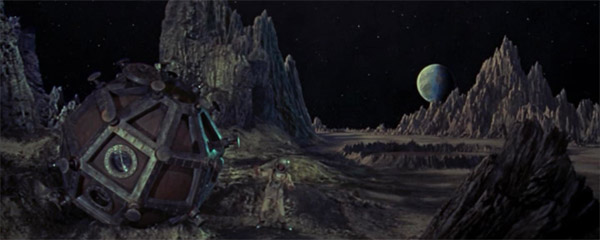Cavor’s insane invention worked too well. In the year of our Lord 1899, genius (or mad) inventor and scientist Joseph Cavor convinced Arnold Bedford and his dear fiancée Katherine Callender, to join him in entering his spherical space vessel powered by a substance called Cavorite.
Arnold and Kate did so on a lark, not believing a word of Cavor’s claims, in spite of the strange and inexplicable experiments he had demonstrated to the engaged couple.
Then, the impossible happened, and the metallic orb with the trio entombed within, escaped the Earth’s gravity with explosive thrust, and launched itself at the Moon.
Now Arnold and Kate were running for their lives back toward the sphere, pursued by the Selenites, a horde of insect-like creatures inhabiting the Moon’s interior, who were convinced that humanity’s martial tendencies were a threat, now that man had achieved space travel.
“Quick, Kate, Inside! I’ll hold them off.”
“Do hurry, Arnold. I don’t know what I’d do if…” She was on the verge of tears, terrified at the prospect of capture or worse by the Lunar insectoid race, but if there was any hope now, she knew it was with her beloved.
“Damn that Cavor for staying behind. What does he think to accomplish?” Bedford let out another blast from his procured alien Tesla coil-ray gun, shattering the exo-bodies of the leading drones pursuing them.
The remainder of the Selenite soldiers, their path momentarily blocked by the corpses Bedford’s deadly aim had produced, gave the valiant Brit his chance to enter the ship and seal the hatch.
He found his courageous Kate already in the restraining net, and taking a similar position, mimicked Cavor’s moments at the controls he had witnessed when the scientist had caused the sphere to leave their mother planet.
The hull of their sturdy craft echoed with the efforts of hundreds, nay, thousands of Selenites to pierce their craft, with both their natural clawed appendages, and with what steel weapons they were carrying, but it was too late.
“We’re off!” Bedford’s cry of exultation was crushed in his lungs as the activated Cavorite completely cancelled the Moon’s weak gravity upon their vessel, and they shot upward faster than a bullet through a vertical shaft above them, and then the window covering at the top.
They were in space again, but this time something was different. Unfamiliar with the controls, Bedford had somehow altered the settings, and they were accelerating at an unheard of velocity, much faster than what Cavor had produced on their outbound trip.
Nevertheless, the welcoming blue orb of the Earth continually loomed larger in their forward view port.
“Sir, Radar is picking up an object rapidly decelerating toward our position.”
The USS Hornet’s commanding officer looked at the Lieutenant reporting to him with an expression of both annoyance and puzzlement. “That can’t be right. Apollo 11 isn’t due to enter the atmosphere for another three hours. Are you sure we aren’t picking up a meteor?”
“Yes sir, we thought that too at first, but it’s reducing speed and changing course. Captain, we know it’s not Apollo, but whatever it is, it’s being piloted.”
On July 24, 1969, U.S. Navy divers managed to rescue a man and a woman from an unknown spacecraft minutes before it sank into the Pacific Ocean 2,660 kilometers east of Wake Island.
For Arnold Bedford and Kate Callender, the trip to the Moon, their brief sojourn, and then return journey had occurred in a matter of days. However, thanks to the mysterious properties of the gravity-manipulating Cavorite and its effects on time, they returned to the Earth 70 years after departure, landing only hours before the second set of men to land on the Moon.
I wrote this for Music Challenge #27: “Space Oddity” by David Bowie #musicchallenge #amwriting #MLMM hosted at Mindlovemisery’s Menagerie.
Today, the idea is to take the David Bowie chart “Space Oddity” and use it to inspire crafting a poem, short story, or other creative work.
Since I’ve taken an interest in steampunk lately, as evidenced by my nascent Keisha Davis series, I thought I’d create something wholly anachronistic.
I mined the plot of the 1964 film adaptation of H.G. Wells’ novel The First Men in the Moon, and juxtaposed it against the Apollo 11 mission, which first landed human beings on the lunar surface in real life.
No, gravitational time dilation doesn’t work that way, so before anyone complains, I am writing fantasy, not hard science fiction, just to have fun and because I can.


Apparently the moon (insect) race of people died out, OR the nasa astronauts never came in contact (perhaps they did and lied about it?) with them.
LikeLike
In the movie, Cavor had a cold and he transmitted it to the insects who, having no resistance, died off. Wells used a similar ploy to get rid of the Martians in “War of the Worlds.”
LikeLike
According to your fiction world Apollo 11 has a surprise waiting for them when they reach the moon…
LikeLike
If they landed at the same site as the Cavor expedition. In the 1964 movie, an aged Bedford is watching the first moon landing in 1964 from a retirement home terrified of what the Astronauts would find. However, all they discovered was ruins and nothing alive. Cavor’s cold wiped out the entire incest civilization.
LikeLiked by 2 people
We’re going to have to be careful when we start exploring planets with life on them, both when we land and if we go home. I wonder how much they keep this in mind when they send out probes to Mars and Europa.
LikeLike
Actually, NASA does everything possible to decontaminate spacecraft before launch, and the Apollo 11 astronauts were held in quarantine after returning from the Moon in case they brought back some unknown “visitors.”
LikeLike
Sounds like a good idea. You already read my Proxima B – story on the same subject. It doesn’t end well there 😀
LikeLike
True, dat. Oh, have you had a chance to read my budding “steampunk” series? I think you’d like it. The latest one is Submersible Disaster. At the bottom are the links to the first four chapters.
LikeLike
I’ll have a look 😉
LikeLiked by 1 person
Neat, I love the time travel aspect of this. Too bad they had such a terrible experience on the Moon, but I’m sure they were quite happy to remain earth bound after their experiences. Thanks for participating in this a couple weeks ago. I appreciate it 🙂
LikeLike
No worries. I finished reading the H.G. Wells novel of “The First Men in the Moon” yesterday, and it ends up being very different from the 1964 movie adaptation. For one thing, there are no women in the novel except for minor supporting characters, and Bedford strands Cavor on the Moon and goes back to Earth. Then, he promptly loses the sphere when some kid gets in after he’s left it on a beach, accidentally activates it, and launches himself into space. Poor, lost kid.
LikeLiked by 1 person
Yeah, poor kid indeed 😦
LikeLiked by 1 person
Fortunately, he’s fictional. 😉
LikeLiked by 1 person
Phew 😅
LikeLiked by 1 person